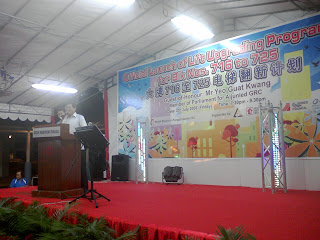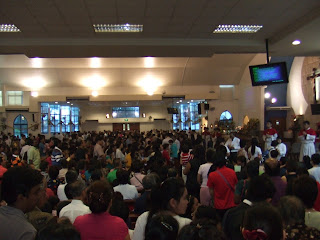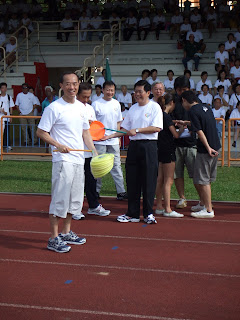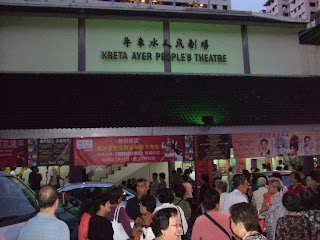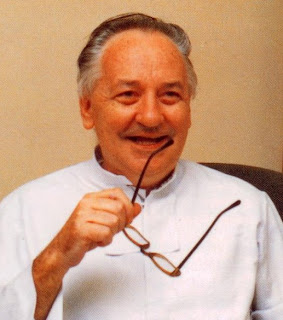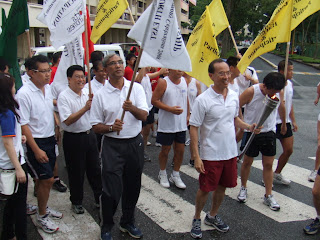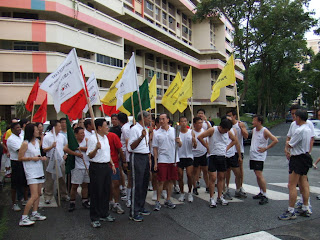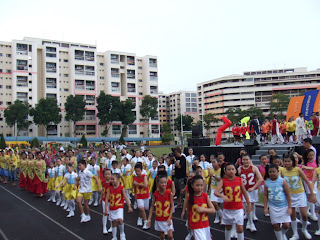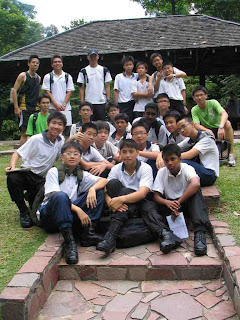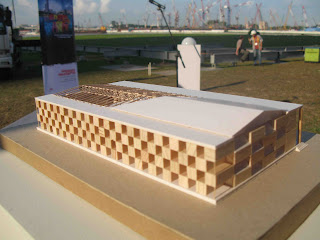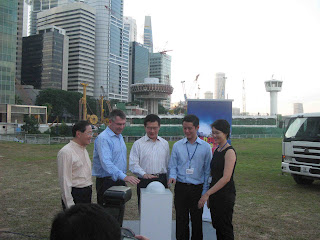[Transcript of 41st AMM/PMC/15th ARF Press Conference]TRANSCRIPT OF PRESS CONFERENCE BY THE CHAIRMAN OF THE 41ST ASEAN MINISTERIAL MEETING, POST-MINISTERIAL CONFERENCES AND 15TH ASEAN REGIONAL FORUM AND MINISTER FOR FOREIGN AFFAIRS GEORGE YEO AT THE SHANGRI-LA HOTEL, 1600 HRS, 25 JULY 2008
Moderator: I welcome all of you to the closing press conference by the Singapore Foreign Minister Mr George Yeo. Before we open up the Q&A, the Foreign Minister will say a few words.
Minister: Thanks Bernard. Dear Ladies and Gentlemen of the media, thank you for coming. Thank you for following the proceedings over the last one week. It must have been as hectic for you as it has been for the participants. Perhaps a little more for you, because when we’ve finished work, you begin yours. And I thank you for your patience because, sometimes, it is not possible to release information to you early enough until we’ve considered it formally among ourselves. It has been an eventful and a fruitful series of meetings since the last weekend. Our main work was the work of the Charter. We’re hopeful that by the end of the year it would be ratified by all 10 countries. There are only three countries left and we see no major obstacles to their ratification. In the meantime, we are acting in anticipation of the ratification. On November 1st, the Secretary-General will be appointing two new Deputy Secretary-Generals to help him because the workload is growing very rapidly. And the committee of Permanent Representatives to the ASEAN Secretariat will be established on 1st January, and all the countries of ASEAN are now looking at names. We also have two more blueprints to firm up – for the security-political community and for the socio-cultural community. So I would say the work of ASEAN itself is in hand.
In addition, two other topics were high up on our list of priorities – one was Myanmar, the other was the Temple of Preah Vihear issue. On Myanmar, we released the Post-Nargis Joint Assessment Report. You covered it, so you know the details. It showed that good work had been done, that ASEAN did right by intervening, by taking the lead in bringing humanitarian assistance into Myanmar, in building a bridge of trust between Myanmar government and the international community. And this work will continue for one more year. We hope that the countries will continue to support Myanmar in its efforts at recovery. Even though there has been no starvation, no outbreak of epidemics, there is much human suffering and there are vast needs. And to the extent that countries around the world and international organisations can help Myanmar, the plight of the people affected will be alleviated. We also discussed the political situation in Myanmar which was somewhat interrupted by Cyclone Nargis. The Myanmar Foreign Minister briefed us on their Roadmap. They had their referendum. We are in no position to judge whether it was well-conducted or not, because it was an internal process. But we know that they’re working towards elections in 2010 according to the new constitution. And the Myanmar Foreign Minister informed us that election laws will be drafted. Aung San Suu Kyi cannot be the Head of State, but he also said it was not clear whether she would be allowed to stand for parliamentary elections. On her detention, we expressed our deep disappointment, asked for early release for Aung San Suu Kyi and other political prisoners. We were told that for Aung San Suu Kyi, the limit of her detention will be, I think, October next year. I and other Foreign Ministers misunderstood the Myanmar Foreign Minister on the first night and gave a different piece of information which I had to correct the following day. We are encouraged that Dr Ibrahim Gambari, Special Envoy of the UN Secretary-General, will be going back middle August, and we hope that his good work will yield good results. And we impressed upon the Myanmar Foreign Minister the importance of the Gambari mission in establishing and in building upon the good work that has been done so far on Cyclone Nargis. Cyclone Nargis, for all the problems that we went through, for all the travails that had to be covered, did create more trust between Myanmar and the world. It turned out that visas were issued and that assistance did reach the furthest corners of the affected areas.
Then we had the Preah Vihear Temple case suddenly erupting. It became quite a big issue during the meetings. We discussed it at some length on the opening night, and following an appeal by the Cambodian Foreign Minister and Deputy Prime Minister Hor Namhong to me the following day, I organised a lunch with all the ASEAN Foreign Ministers. And because the Thai Deputy Prime Minister had no mandate to attend any additional formal meeting, we had what in diplomatic language we call a non-meeting. At that non-meeting, I as Chairman of ASEAN, consulted intensively all the Foreign Ministers of ASEAN about their views on the request by the Cambodian Foreign Minister to establish a contact group. That idea found favour with many ministers, but there was no consensus, and Thailand said that they should be given a bit more time to work the bilateral approach. And in the meantime, Cambodia has taken the issue to the UN Security Council, on which two ASEAN members sit – Vietnam, now in the Chair, and Indonesia. There’s a view that this may be a little premature but since it has been raised, it will be discussed. But the matter should come back to ASEAN and both sides will be asked to pursue the bilateral effort first, and not allow what is really a small issue, which was a non-issue in the past, to suddenly become a big issue.
Then, on our external relations, we had our two important regional groupings – ASEAN+3 which celebrated its 10th anniversary last year. It is maturing, and for the first time, we decided to meet in retreat format, which is a format we reserve for our more intimate meetings, and also with an agenda where ministers could interact with each other in a more natural and spontaneous way. All of us also agreed to establish a US$3 million ASEAN+3 Cooperation Fund.
Then, for the first time, we had the first Informal Consultations of the EAS Foreign Ministers meeting. Again, loosely structured so that people could speak freely, and there is a growing sense of the importance of a wider grouping which brings in India, Australia and New Zealand. It is a leaders-led organisation, but it is important that what the leaders agree on should be followed up, and the leaders may sometimes be guided on the important issues that are affecting the region as a whole. So that was a plus.
After that we had our various PMC meetings with many countries, taking place back-to-back one after the other and simultaneously. They were useful. We had very good attendance. From the US, we had Condi Rice. Although she could not come to the last two meetings, we understood why. In fact, I made the point that we want only a modest claim on the attention of the US. If the US Secretary of State spends a lot of time on ASEAN, it must mean that ASEAN is a problem area. Her time has naturally to be focused more on problem areas like the Middle East and Northeast Asia. But we had a good meeting, and one in which issues were freely raised, including Myanmar. And we’re very appreciative that many of our Dialogue Partners were so unstinting and so immediate in response to the tragedies in Southeast Asia after the tsunami, after Cyclone Nargis, after earthquakes and so on, and we thank them. And I believe that ASEAN’s omni-directional diplomacy is succeeding, and perhaps succeeding beyond expectation. And so its culmination in the ARF – 27 ministers with ASEAN as the core. Now, that’s quite remarkable. I was in the chair and I looked around. We had the US, the most powerful country on earth. We had Russia with, I don’t know, maybe 15 or 18 million square kilometres. We had the two most populous countries, China and India. And we had small countries, like Singapore and Brunei, sitting around a table on the basis of sovereign equality of nations. And we had good discussions this morning, going over the issues confronting Asia. We talked about the Six-Party Talks. We talked about terrorism. We talked about Preah Vihear and East Timor, the success of Truth and Friendship Process. We talked about the counter-terrorism. We talked about problems of food and energy security, disaster management and so on.
On disaster management, we went quite deep into things that we must do – establishing coordinating nodes, linking up these nodes, establishing procedures, defining closer procedures governing the use of military resources, exercising the procedures that we have in place in small groups and in larger groups. We will even be having designated forces on stand-by readiness so that countries know what the things they can call for are and at what timeframes should there be such a need. Of course, we recognise at the same time that every country is autonomous and no aid can be forced on any other country.
We discussed Northeast Asia and it is a tribute to ASEAN that the first ever Six-Party Foreign Ministers Talk should be held on the sideline of ASEAN meetings. We did not play host in Singapore. We merely provided chairs and tables as well as some refreshments, but we bathe in the reflected success. Last night, when those six ministers came to the Istana and as I shook their hands, I saw a certain relief and I saw smiles on their faces. By all accounts, the talks went much better than any of them had expected before the meeting. I believe that is a feather in ASEAN’s cap. It shows that we have been able to turn our weakness into our strength.
We are 10 countries and an unlikely collection of countries, big and small, at different levels of economic development, and very diverse. But 10 countries in between the two big civilisations of China and India determined that we should maintain our own autonomy and position in the world, and clumping together, convinced that if we do not hang together, we will hang separately, but neutral and open to all, and making ourselves useful to everybody. And so they come here and they use our facilities for their own meetings because their own meetings are very often not as relaxed as ours, and that is something that we in ASEAN should be proud of.
You also saw earlier the accession of DPRK to ASEAN’s Treaty of Amity and Cooperation, which is quite an unexpected development. When we first broached it to them, we were not quite sure that they would be interested. But they were interested and they were very careful in going over the language and checking with us what it meant, and then agreeing to come and expressing their desire for closer relations between the DPRK and countries of Southeast Asia. We are not a major player in the Korean peninsula, but we can offer them an alternative path into the future. Vietnam, for instance, should really be a model for them because Vietnam, like North Korea, is a Communist country with a centralised organisation with a single political party, but is opening up its economy, growing very fast with a growing middle-class. And if North Korea can travel the same path, it too can derive the same benefits.
So today, and it is a relief to all of us in the Singapore team, we hand over the chairmanship to Thailand. Thailand will be in the chair for a year and a half because of the re-synchronisation of the ASEAN calendar to the ordinary calendar starting 1 January 2009. Although a Foreign Minister has not yet been appointed in Thailand, Thailand was well-represented by Deputy Prime Minister, Sahas Bunditkul. Some people asked me whether the domestic political difficulties in Thailand will affect the quality of its stewardship of ASEAN. I remind them that among the countries in Southeast Asia, the country with the oldest foreign policy establishment is Thailand, going back over a 100 years and one which kept Thailand independent while the rest of us were colonised. You could not have achieved that position without a very strong foreign ministry with a very professional core group of officials and with its own discipline and traditions. So we have reasons to be confident that the chair of ASEAN is in good hands.
So I end here and I will be happy to take your questions. Sorry it was a bit long, but we had a lot of meetings.
Q: Ramesh from Channel News Asia. Taking up your last point, Minister, about Thailand now in the Chair, what is ASEAN’s hope for Thailand and Cambodia as far as the Preah Vihear issue is concerned. Definitely Thailand would now be seen as a shining star of ASEAN and surely ASEAN would not want Thailand to be embroiled in this issue far too long, affecting the grouping’s credibility.
Minister: I think both the Thais and the Cambodians are very aware of this, and the glare of ASEAN interest and international publicity would act as a restraint on extremists on both sides to behave in an irresponsible way. Preah Vihear was discussed at almost all our meetings and it will be discussed at the UN Security Council, so both sides know that they are being watched and that their arguments are being carefully analysed. And everyone who is watching will be making his own judgment of who is right and who is wrong, who is reasonable and who is not. Next question please.
Q: I'm Jim Gomez from the Associated Press. Sir, we heard that during the ARF discussions, there was a proposal by the Philippines and the United States to conduct a region-wide disaster response training, including the possibility of moving military forces across borders to respond to disasters. Can you tell us more details about this proposal, and in particular, how this can prevent the problem that occurred in Myanmar when the international assistance was stalled in the crucial initial weeks during the cyclone?
Minister: It makes a lot of sense to conduct such exercises. You do not want to be working together for the first time when there is a disaster. If you've practised before, if you know the radio frequencies, if you share a common language, if you have common procedures, then you can act so much more effectively in a disaster situation. And I think many of us are very pleased to hear that the Philippines and the US would be conducting such an exercise, and as the Chair I tried to encourage as many countries to participate as possible. In the same way, the reason why Singapore was able to play an effective role in Aceh after the tsunami, was because between the Singapore armed forces and Indonesian armed forces, we have a long tradition of joint exercises. In fact the officers knew each other, spoke the same language, and were therefore able to act effectively together, almost as a single unit. And that's what we want. But we don't have to include everybody, because some may have reservations, some may not yet be ready, but as many who are prepared to work together should come together. After all, it is for a very good cause.
Q: I am Jason of Agence France Presse. Was the Thailand-Cambodia dispute officially tabled in the ARF meetings?
Minister: Yes, it was raised by Cambodia, and responded to by Thailand, and a number of countries expressed their views.
Q: And what were the other Dialogue Partners' reactions?
Minister: As to be expected, all counselled restraint, speedy resolution, and a return to status quo ante.
Q: And said earlier it's a bit premature for the UN Security Council to take the issue? Could you expound on that please?
Minister: It should not have to go to the UN Security Council. It was not a problem, even a few weeks ago. It has suddenly become a problem. Why has it become a problem? Well, we know the background. In fact, the idea was, because this is a very interesting site, a world heritage site, both sides should promote tourism. And it's something which should enhance Southeast Asia as a whole, not become a source of conflict between two countries.
Q: Augustine from Channel News Asia. Just picking up on the earlier question, but not so much on military forces in countries and ASEAN countries coming together for exercises. In my conversations with your Dialogue Partners, there is a keen interest in setting up, perhaps even a centre in the ASEAN Secretariat for expertise on training to come in, to get this much talked about disaster preparedness off the ground, because Mother Nature sometimes just doesn't give us warning. What are your personal thoughts, Minister on how this should take shape and form?
Minister: We will need many nodes in the region – some for training, some for command and control in an emergency. And these nodes should be linked up together, so that if we need emergency resources we don't have, we can call upon countries further away. There will certainly have a big node in Jakarta because we have established a disaster management centre, and it will have to be enlarged, it will have to be fleshed out, it will have to be properly established with procedures, exercises, and it will link up with the national centres. I think all countries have national centres. And then the other centres in China and the US and elsewhere, we should link up with them. So they can help us, we can help them, and we can share information. And such a node may well be very valuable, should there, for example, be a pandemic crisis and we need to act in concert. What you want is better coordination, common frequencies, and a common vocabulary, so that we don't misunderstand each other when we are in a hurry.
Q: Naoko Nishiumi from NHK Japanese Broadcasting Corporation. I would like to ask what kind of discussion was made in the ARF on the North Korean denuclearisation. What kind of wording would you use in your statement?
Minister: I think the ARF statement will be released to you. As was to be expected, quite a lot of time was spent talking about the situation on the Korean peninsula. The nuclear issue, the six-party talks, the Japanese raised abduction, the South Koreans were naturally concerned about the recent shooting of a woman tourist in the Kumgang mountains. But this time, the mood was different. This is my fourth ARF, and the discussion on Northeast Asia was a very different discussion from those that I've heard in the past, and I attribute this to the progress that's been made in the Six-Party Talks, and to the good meeting which they had yesterday. I said after the North Korean Foreign Minister's made his intervention that I heard in his speech many positive points and many sitting around nodded their heads.
Q: Good afternoon, Minister. My name is Pastelero Mogato from Reuters. So you said a while ago about this stand-by ready force to respond to disasters in the region, what was the sentiment of the ARF partners? And would that cause any problem because of the presence of military forces in some of the countries, because some of them do not want foreign soldiers on their soil? How would this be resolved? Is the template based on the UN Humanitarian Assistance a good model for ARF? Thank you.
Minister: It is for the country in need of help to decide, we can't force help on that country. In Myanmar, the warships which were carrying supplies anchored outside their territorial waters caused confusion, created distrust, which in fact impeded the flow of international aid into Myanmar at that time. In the case of Indonesia after the tsunami, foreign military forces were welcomed with no impediment, and the result was great speed in bringing assistance to the affected areas. So it is for the countries affected to decide whether or not they wish to accept foreign aid, and in what form. But from the perspective of the aid-providing countries, it is good that we exercise different combinations, so that we can deploy in different combinations. And certainly, to be effective at a high level, we will always need military forces. Someone said that of course, the ultimate command in a disaster situation should be a civilian command, which I felt was a very fair point. But we did identify, clarifying the relationship between the use of military assets and the use of civilian assets as a key issue for discussion and elaboration by officials. And this they will follow up on in inter-sessional meetings.
Q: I'm Raphael Minder. I’m with Financial Times, Asia Correspondent. A couple of questions following up on this, when do you think such exercises, led maybe by the US, will actually take place? Do you have any sense of a timetable? Do you think, given your last remark…
Minister: Surin just told me 2009.
Q: 2009.
Minister: Yes.
Q: Given your last remark, is it a problem in any way that the US should be behind this initiative, having seen what happened in Burma when US warships led the way in terms of trying to…
Minister: No, not at all. In fact I think we are grateful to the US for taking this initiative. But there could be other initiatives, led by other groups, other countries, and these can go in parallel, and I believe they're complementary. And like inkblots, let each grow, and eventually overlap one another.
Q: And then, just coming back to the Temple dispute, can you just perhaps detail… there seem to have been some countries quite firmly opposed to the idea of acting as a regional broker. What was their argument?
Minister: Acting in the regional…?
Q: Using ASEAN as a regional broker, a peace broker for an agreement. Who were these countries and what was their main argument? Did they think that ASEAN should just keep out of that sort of conflict?
Minister: No, no, all countries agreed that should there be a need, ASEAN stands ready to assist, and that facility should be on the shelf and ready to be used. But whether or not we need to reach out for that facility on the shelf must depend on the two countries which are directly involved. Cambodia wanted it to be used immediately. Thailand felt that bilateral meetings should be given a chance to succeed, and they felt, with some justification, that perhaps the next meeting should be held soon after this Sunday's elections in Cambodia, and perhaps the results would be better. But in such bilateral disputes, you've got to listen to both sides, because both sides have their cases to make.
Q: And just the idea of a food security summit in Indonesia in December, is it now a reality and is there any prioritisation of the issues for that summit?
Minister: We discussed that, the officials are working on this, the agricultural people. They've got to decide whether there is sufficient agreement for there to be deliverables at the summit. The leaders should not meet unless we are reasonably confident that there are concrete deliverables. So the officials will work on this first.
Moderator: Final question?
Minister: Oh, looks like we're done.
Moderator: Thank you very much, Minister.
. . . . .

 Watch the video here
Watch the video here




